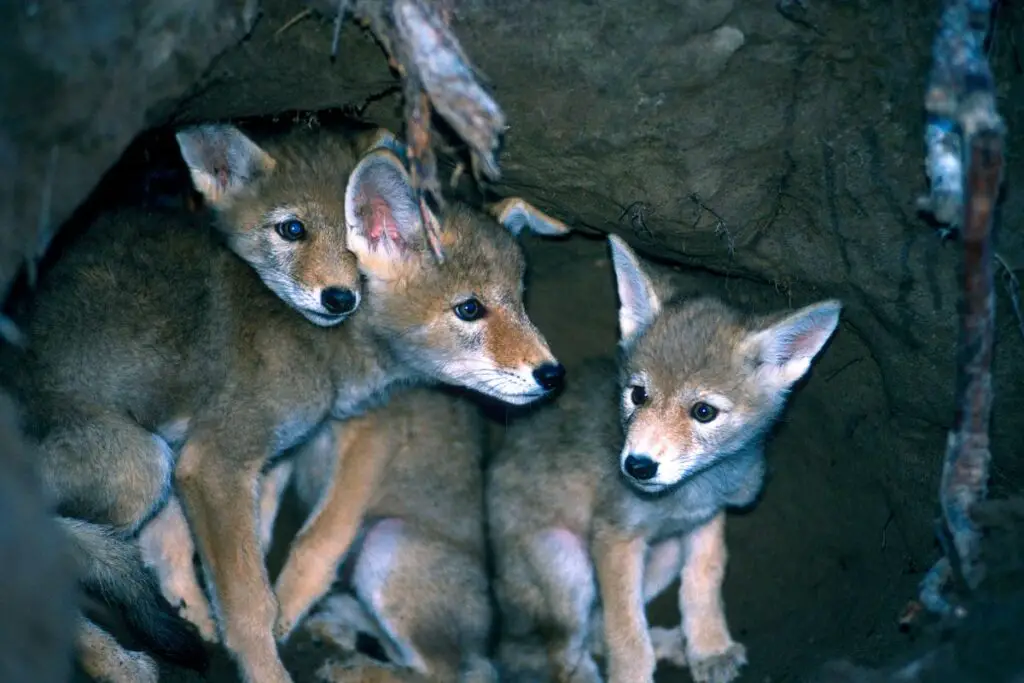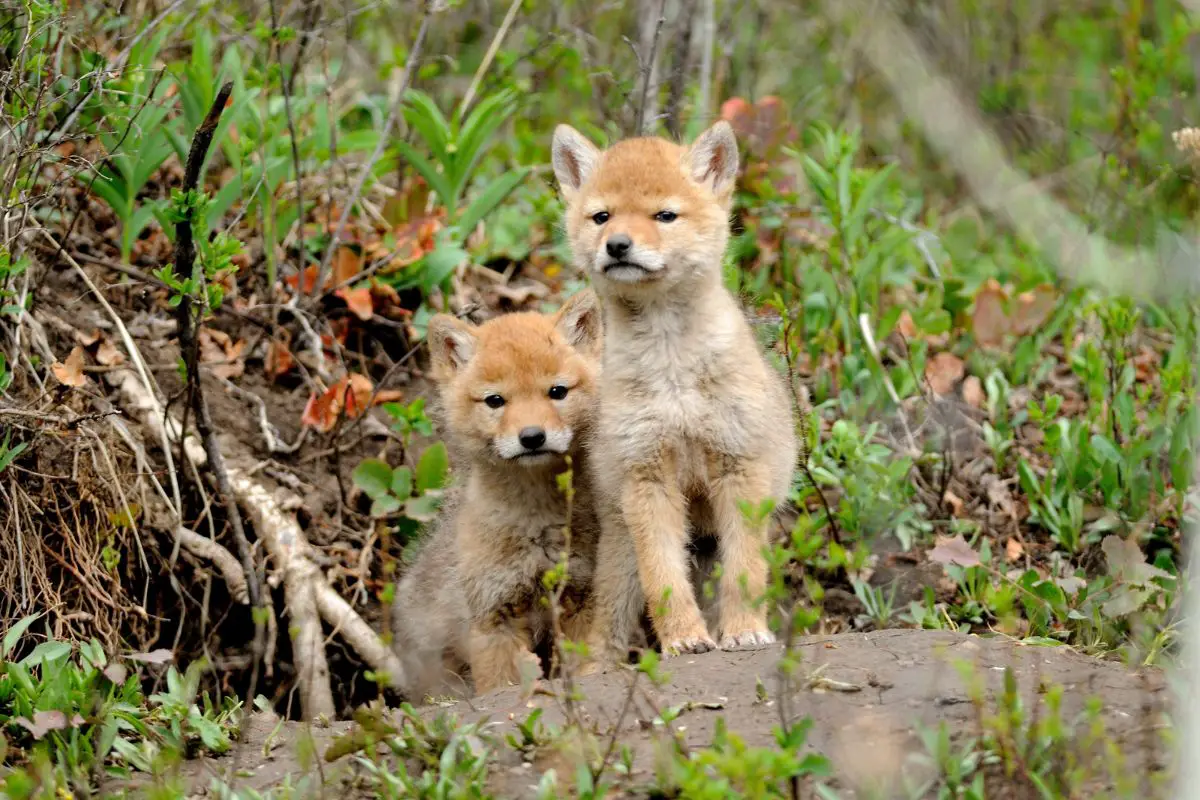Life in the wild can be tough. Especially, when you’re a newborn. For a coyote pup, even when you’re cute and lovable, life is full of challenges.
While life for coyote pups can be difficult, it is also full of achievement and triumph. Fortunately, they have parents who have strong family ties and share the responsibility of raising the young pups.
What are baby coyotes called? Baby coyotes are known as pups, whelps, and puppies.
Coyote Whelps (Pups)
Coyote pups are born in April or May and are born completely blind and deaf. They open their eyes at around 12 days. They stay in the den with their mother until they are weaned, at about six to eight weeks old. After 8 months they will leave their parents and disperse.
The parents, and other members of the pack, teach them how to hunt, play, and stay alive. When coyotes leave their mother and strike out on their own they are transient.
When are Coyote Pups Born?
The alpha male and female are the only two coyotes in a pack that mate. Other coyotes in the pack, usually children from a previous year that have stuck around to help, are subordinate and are known as beta coyotes.
After mating, the female coyote prepares several dens in which to raise her new litter. Having more than one den fairly close to one another allows the pair to move the pups to safety in case the den where the pups are located gets compromised.
Many situations can arise that cause a den to be deemed unsafe by the parents. For example, a flea infestation, flooding, or people or animals nearby that pose a threat.
It is possible for a female coyote to have more than one litter in a year but this is rare. They usually have one liter born in the spring, sixty-three days after mating.
One of the things that make coyotes so good at surviving in their natural habitats is their ability to adapt. A good example of this is the number of pups they have per litter.
This changes depending on their home range size and the availability of food. When their home range is small and food is scarce, they have smaller litters. Fewer pups to feed.
One litter can have as many as eleven or even twelve pups. The average litter size, however, is six pups. As noted, the litter size almost always has a correlation with the food sources available.
What Do Coyote Pups Look Like?
When coyote pups are first born they look much like domestic dog puppies, fox kits, and raccoon kits. It doesn’t take long, however, to distinguish them from the latter two.
At this stage, the pups are only about one-half pound (227 grams) in weight. Their ears are flat against their heads, which are more rounded, and they lack the long snout of their adult counterparts.
The pads at the bottom of the feet are pink after they are first born. After ten days the pads turn black. The umbilical cord remains for the first three days of life on a coyote pup.
Adult coyotes have two types of fur. Guard hairs are long and coarse. These hairs are made to shed water and keep them dry. Also, they have shorter, softer underfur to keep them warm.
Their fur is very fine and light, usually a tawny brown, with darker areas on their backs, ears, faces, and tails. By three weeks they have fuzzy, longer fur that has darkened and becomes more coarse but still lack their full coats. After two or three months, coyotes start to resemble their adult parents in the way they look and their actions.

Coyote Pup Sounds
Coyotes are the most vocal of wild dogs. This is why naturalist Thomas Say named them Canis latrans which translates to “barking dog”. Their very vocal approach to communication has also earned them the title of “North American Song Dog”.
The young pups are only vocal when it’s time to feed. Their small yips and whines can be heard as they approach their mother to suckle.
The rest of the time they are sleeping and when the mother is gone they stay quiet and try to snuggle up as close as they can to one another. A pup will feel distressed, whining, howling, and yipping until reunited with its family members.
Vocalization of the pups increases with the start of the weaning process. When the mother comes into the den after being away, the pups will follow her, whining and yelping while attempting to suckle.
This behavior continues after they start to eat solid food. At this point, besides vocalizations, they also start to wag their tails, paw at their mother and lift their muzzles to hers.
Raising a Litter of Coyote Pups
The male coyote hunts and defends the territory while the female prepares the den gives birth and takes care of the pups. When the pups are first born they are completely helpless and blind.
For the first week, the mother does not leave the den that she has made for her and her pups. The male coyote brings food for her to the entrance of the den.
After the first week, the female will make short trips to eat and drink. Often, beta coyotes will care for the pups while she is gone.
At first, the pups need the mother to put pressure on their bellies to initiate urination and defecation. The mother then eats the waste to keep the den and pups clean.
Pups will venture just outside of the den at three weeks old. Outside the den they will play, pouncing on insects and each other in preparation for their role as hunters.
At this stage, they are much like the puppies of Canis familiaris, the domestic dog. They will growl at each other, play fight, and chase their tails.
Their teeth begin to fully emerge at six weeks of age. Over the next week or two they will be weaned and start eating solid food.
At first, the female will eat a bit of food and then regurgitate it so that the pups can eat. The beta coyotes, who are female, assist with the feeding of the pups and will play and nurture them along with the mother.
The Beta coyote also helps with guarding the home range, especially around the den. Soon after the Adult coyotes will start bringing whole prey for the pups to eat.

Want to learn more about their den? Check out our article on Coyote Dens!
When Coyote Pups Start to Eat Full Prey
The pups’ first whole animals that they will eat on their own are usually small mice. They eventually graduate to larger animals such as squirrels, rabbits, and gophers.
During this time the mother and pups sleep inside the den. Soon after the pups start eating on their own they will abandon the den and start sleeping outside with the rest of the pack.
This occurs two to three months after they are born. The pups hone their hunting skills on nearby grasshoppers, mice, and other insects.
The adults continue to bring their kills for the young ones to eat until they are four or five months old. At this time they start hunting with the adults.
They will spend the rest of the summer and fall months perfecting their hunting skills and playing with each other and the other members of the pack.
When Do Coyote Pups Leave Their Mother?
Late in Autumn is when most of these animals will strike out on their own. No longer helpless puppies, they will spend the rest of their first year of life hunting, eating, and growing into mature adult coyotes.
Even when many coyotes leave to find their own mates and start their own packs, not all of them will go. The ones that do will be transient for a year or even longer.
The ones that stay behind will be beta coyotes. These coyotes will help the alpha pair by protecting their home range and raising the next year’s pups.
Beta coyotes from previous years will often depart in the fall to start their own packs. Coyote pups face many hardships in those early months.
Things like hunger, disease, and predators will take their toll on many of them. Only half of the pups born will make it through winter and move on to be yearlings.
Related Questions
Can coyote pups survive without their mother?
Coyotes in general are resilient survivors but the chance of them surviving without their mother is almost zero. If they are old enough and they have other members of the pack to look after them, their odds improve. Half of them won’t survive even with the care of both parents.
Do coyote pups make good pets?
Coyotes are wild animals and should not be kept as pets. Unlike our familiar friends and pets, domestic dogs, who have been bred and trained to be around humans for thousands of years, coyotes and humans don’t do well together. They are cute little pups but as they grow older they will become more aggressive and independent.
Additional Sources
Mattern, Joanne. The Coyote. Mankato, Minn.: Capstone Press, 1999
Cavendish, Marshall. “The Marshall Cavendish International Wildlife Encyclopedia.” COC COR, edited by Maurice Burton and Robert Burton, Rev. ed., vol. 6, Marshall Cavendish Corporation, 1991, pp. 682-685.
- Hero Farm Dog Survives Epic Battle with Coyote Pack - December 9, 2024
- The 10-Minute Bedtime Routine That Changed My Dog’s Sleep Forever - November 29, 2024
- Creating a Safe Space for Nervous Pets: Your Guide to Pet-Friendly Havens - November 25, 2024

